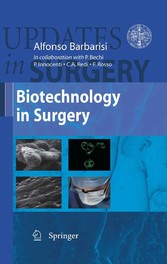Suchen und Finden
Title Page
2
Copyright Page
3
Foreword
5
Preface
6
Table of Contents
8
1 The Philosophy of Biotechnology
16
1.1 Introduction
16
1.1.1 Genomics (fundamentals)
19
1.1.2 Proteomics (fundamentals)
20
1.1.3 Cell Therapy
21
1.1.4 Metabolomics: Potential Applications to Surgical Diseases F. Tarantini, M. Giannelli, D. Boni
22
1.2 The Role of the Surgeon in Translational Research
24
1.3 The Role of Biotechnology in Oncologic Surgery
25
References
28
2 New Approach to Diagnosis and Prognosis
30
2.1 Secondary Peritoneal Carcinomatosis and Biotechnology: a New Approach to Diagnosis and Therapy
30
2.1.1 Introduction
30
2.1.2 Pathophysiology
30
2.1.3 Future View to Diagnosis and Therapy
32
2.2 Pre-endothelial Cells and Prognosis of Intestinal Adenocarcinoma
33
2.2.1 Introduction
33
2.2.2 Endothelial Progenitor Cells and Post-natal Vasculogenesis
34
2.2.3 EPCs, Tumor Angiogenesis and Metastasis
34
2.2.4 EPCs as a Potential Biomarker for Tumor Angiogenesis
35
2.2.5 Molecular Markers of Tumor Angiogenesis and Antiangiogenic Drug Activity
37
2.2.6 EPC as Cellular Vehicles for Anticancer Therapy
37
2.2.7 Conclusions and Future Perspectives
37
2.3 Microarray Gene Expression of Pancreatic Carcinoma
38
2.3.1 Introduction
38
2.3.2 Microarray
39
2.3.3 Microarray and Pancreatic Cancer
40
2.3.4 Conclusions
41
2.4 The Significance of Circulating Tumor Cells as a Prognostic Marker for Colon Cancer: a New Biotechnology
42
2.4.1 Introduction
42
2.4.2 Personal Experience
43
2.4.3 Conclusions
44
2.5 Advanced Diagnostic Applications
45
2.5.1 Introduction
45
2.5.2 Immunogold Labeling
45
2.5.3 Thyroid Lesion
46
2.5.4 Galectin-3 and Tumors
46
2.5.5 Our Experience
47
2.5.6 Conclusions
50
References
50
3 Biomolecular Staging: Reality or Future Perspective?
56
3.1 Introduction
56
3.1.1 Apoptosis Related Genes
57
3.1.2 Oncogenes
58
3.1.3 Inhibitors of Cyclin Dependent Kinases (Cdk)
58
3.1.4 Adhesion Molecule Expression
59
3.1.5 Flow Cytometry DNA Content
59
3.1.6 Conclusions
60
3.2 Molecular Biology as the Identity Card of Human Tumors
60
3.3 Interventional Timing According to New Insights in Basic Research
65
3.4 Cellular Biology: A Way of Predicting Cancerogenic Progression, Prognosis and Response to Adjuvant Treatment
68
References
72
4 Technology for Biotechnology
75
4.1 Nanotechnology and Nanofabrication
75
4.2 Biosensors
80
4.3 Nanodiagnostics
83
References
86
5 Regenerative Medicine: Current and Potential Applications
88
5.1 Scaffold and Molecular Signals for Tissue Engineering
88
5.2 Cell Source for Tissue Engineering
90
5.3 Skin
95
5.4 Lung Epithelium
97
5.5 The Bioartificial Liver
99
5.5.1 Introduction
99
5.5.2 Bioartificial Technical Support
100
5.5.3 BAL Structure
100
5.5.4 Clinical-Laboratory Parameters Assessed
101
5.5.5 Clinical Trials
102
5.5.6 Conclusions
103
References
104
6 In Vivo Imaging of Regenerated Tissue: State of Art and Future Perspectives
108
6.1 Introduction
108
6.2 Conventional Imaging of Regenerated Tissue
109
6.3 Molecular Imaging of Regenerated Tissue
111
6.3.1 MRI Molecular Imaging: Contrast Agents and Reporter Genes
112
6.4 Conclusions
114
References
114
7 Biotechnological Approaches to Hemostasis and Molecular Mechanisms of Wound Healing
117
7.1 Biotechnology for Hemostasis Control
117
7.2 Hemostatic Agents and their Mechanism of Action
118
7.2.1 Collagen and Gelatin Sponges
119
7.2.2 Oxidized Cellulose
121
7.2.3 Fibrin Glue
121
7.2.4 Synthetic Sealants and Adhesives
123
7.2.5 The Future: Innovative Biotechnology for Hemostasis Control
124
References
125
8 Gene Therapy
127
8.1 Gene Therapy
127
8.2 Gene Therapy for Neurodegenerative Diseases
131
8.3 Local Gene Delivery for Tissue Repair in Surgery
135
8.3.1 Introduction
135
8.3.2 Barriers to the Delivery of Genes for Tissue Repair In Vivo
136
8.3.3 Viral Vectors
136
8.3.4 Non-viral Vectors
137
8.3.5 Tissue Engineering Scaffolds
138
8.3.6 Conclusions
138
References
139
9 Stem Cells
143
9.1 Philosophical and Lexical Issues
143
9.2 Origin, Animal and Vegetal Models
145
9.3 Somatic and Embryonic Stem Cells
146
9.4 Stemness Genes
151
9.5 Induction of Pluripotency
152
9.6 Stem Cells in Regenerative Medicine
154
9.7 International Legal Framework: Stem Cell Biopolitics and Scientific Citizenship
155
References
159
10 Cancer Stem Cells
162
10.1 Origin and Evolution of the Cancer Stem Cell Paradigm
162
10.2 Functional Genomics of CSCs
163
10.3 Molecular Biology of CSCs
164
10.4 CSCs and Carcinogenesis
165
10.5 CSCs and Tumor Recurrence
166
10.6 CSC and Metastases
167
10.7 In Vivo Imaging of CSCs
169
10.8 CSCs and Colon Cancer
170
10.9 Breast Cancer and CSCs
171
10.10 CSCs and Ovarian Cancer
172
10.11 CSCs and Lung Cancer
173
10.12 CSCs and Pancreatic Adenocarcinoma
174
10.13 CSCs and Prostate Cancer
175
10.14 CSCs and Glioblastoma Multiforme
176
10.15 Eradication of CSCs
177
References
178
Appendix The Impact on Surgical Practice of Recent Advances in Biotechnology. Interactions Between Inherited and Environmental Factors in the Occurrence - and Biological Behavior - of Diseases of Surgical Interest
180
Lesson from Inherited Multitumoral Syndromes
180
Lesson from Inherited Multitumoral Syndromes Including Early Aging
183
Lesson from Hepatobiliary and Pancreatic Malignancies
185
Lesson from Liver Regeneration
185
Lesson from Genetics and Genetic Engineering or Advances in Biotechnology: Surgical Implications
187
Lesson from Pollution Related Diseases
188
Lesson from In Vitro Studies of Airborne Pollutants on Synoviocytes and Sperm Cells
189
Lesson from Asbestos Exposure and Mesothelioma in Humans
190
Suggestions to Policy Makers to Tackle Health Effects from Air Pollution
196
Lesson from Epidemiologic and Genome-wide Association Studies
196
Conclusions
198
References
199
Subject Index
202
Alle Preise verstehen sich inklusive der gesetzlichen MwSt.























